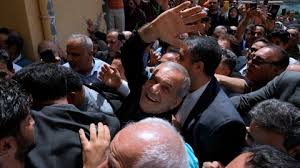In less than 50 years, Iran’s reins have shifted from a hardliner and anti-Western president to a reformist president.
Massoud Pezeshkian was elected Iran’s president on Saturday. Massoud was the health minister under the reformist president 19 years ago.
Reformists have had to face sanctions in the run-up to subsequent presidential elections.
Pezeshkian was also not an ideal candidate for the reformists, but when they felt there was a slight chance of them winning this time, they put all their might into capitalizing on this opportunity.
But the council has been accused of being biased towards reformists. Reformists ruled the country from 1997 to 2005.
For the last three elections, reformists have been complaining that all their high-profile candidates were rejected by the Guardian Council.
They alleged that only those candidates were approved who were less known to people. That is why they lagged behind their conservative rivals.
This time when former President Ibrahim Raisi died in a helicopter crash on May 19 and elections were announced, many felt that the old story would be repeated.
When the Guardian Council finalized the list of candidates on June 9, even then there was little hope of a good performance by the reformists.
The council approved the names of six candidates, one of which was Masoud Pezeshkian. He was the only person whose political views did not match those of the theoreticians.
The theoreticians are more conservative than the reformists. They support radical Islamic ideology.
Iran’s supreme leader Ayatollah Ali Khamenei also comes from this camp. This is the reason why the Islamic Revolutionary Guards Corps (IRGC) is closer to the theoreticians than the reformists.




